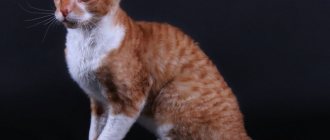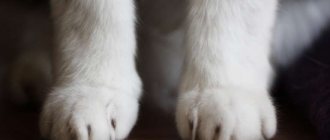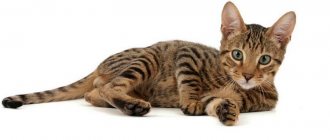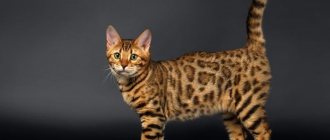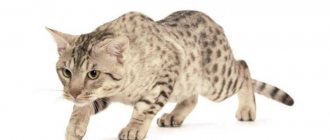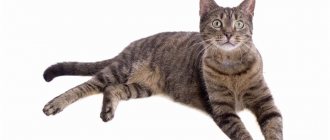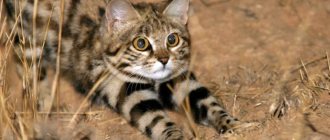Serengeti cat
- Fact 1:
The author of the breed is Karen Sauzman, a resident of Canada. - Fact 2:
The breed is included in the TICA list of experimental breeds - Fact 3:
The weight of cats starts from 8 kg, and the weight of cats can reach 15 kg. - Fact 4:
Cats live on average 13-15 years
The Serengeti is one of the rarest cat breeds in the world. Selection work to create this exclusive breed started in 1994, and four years later the first working standard was drawn up, but currently the breed is still in its formation stage.
The author of the breed is Karen Sauzman, a resident of Canada and a geneticist by training. When creating the Serengeti, Karen set out to create a domestic cat that would look like a wild serval. This fact is reflected in the name of the breed: the name “Serengeti” is a national park in East Africa, which is home to servals.
History of appearance
Karen Sauzman decided to create a pet in the 90s of the last century. Most importantly, he should look like the serval that captivated her with his unusual color.
To create a new cat, Orientals were crossed with Bengals. As a result of these experiments, graceful, handsome men appeared.
Serengeti means “endless plains” in Maasai. In fact, they turned out to be incredibly similar to serval.
Kitten price
Currently, there are only about 200 individuals recognized as purebred Serengeti cats, and only 16 professional breeders of cats of this breed. The best nursery remains the Karen Sauzman nursery.
Buying a kitten in Russia is problematic, but possible. The cost will be approximately 30,000 rubles. It is easier to buy a cross between a Serengeti and a Bengal or Oriental cat (breeding a Serengeti with cats of these breeds is officially permitted).
What's prohibited
Has official status in TICA (International Cat Association).
But due to the fact that at the moment the conditions (at least 50 nurseries) under which the breed is allowed for exhibitions are not met, they are not exhibited.
Appearance
Eastern genes gave the cats an elongated body, muscular long legs and beautiful honey-colored eyes. If you look at these animals, it may immediately seem that they are fraught with danger. This is due to the fact that cats look very much like their wild relatives. But in reality they are affectionate, kind and sweet creatures.
Serengeti cats have large ears, which can make their heads appear to be very small.
The nose is wide along its entire length, the nose is dark or brown with a dark outline. The vibrissae are long and usually white. The eyes are wide-set, round, honey-colored, and can also be hazel or light green.
Legs are long and straight. The paws are not very large, oval. The neck is oval, widening towards the shoulders. The body is somewhat elongated, athletic in build with well-developed but not outstanding muscles. Already two months old kittens have all the features of a sporty, elegant build and a well-complex body. The back is straight and level. The tail is of medium length, the tip is always black. The Serengeti is quite large: cats can weigh 8-12 kg, and males - up to 15 kg.
The coat is pleasant to the touch and has a spotted color. This trait makes the breed similar to others with a spotted tabby color: Egyptian Mau, Ocicat, Savannah. The spots on the body can be smoky black or black oval in color. Sometimes you can find individuals with spots convex in the horizontal direction. The walrus has a characteristic tabby pattern: arrows from the corners of the eyes, dark eyelids, the letter M on the forehead and a lightened chin. And although this is not a mandatory feature, it is still desirable. The Serengeti has no undercoat, so the coat hardly sheds.
Character
The animals are friendly, with a sociable character. They persistently demand attention and love communication. To be noticed, he will butt heads, get under your feet, lie down on the keyboard, etc.
Note!
Singapore cat: character, photo, price, breed description, reviews, how to buy, how to choose, maintenance, care and owner reviews
Scottish Straight: cat photo, kitten prices, breed description, character, reviews, maintenance and care, nutrition + interesting facts
Chausie - overview of the breed, character and breeding characteristics. Price for a kitten and tips for choosing a purebred cat (115 photos)
They cannot stand loneliness. If treated poorly, they become aggressive. You shouldn’t pamper yourself with attention, because for them there is never too much of it.
Leader. Lives well with other pets of the owner, but provided that he is the main one. He fights for the championship until the end. Persistent, brave. If it seems to him that the owner is in danger, he will immediately rush to defense, even if it is a dog.
Constantly on the move. They love to jump, play, and climb. They like to throw off small objects with their paws, so it’s better to put anything that breaks in the closet.
The house must have scratching posts, various complexes, stairs, and toys. This is the only way to guarantee that your furniture will remain in order.
Health and physical development
The genotype of wild ancestors endowed the Serengeti with strong immunity and good health, however, if not kept correctly, cats of this breed can quickly develop kidney stones, and if soft food predominates in the diet, tartar appears.
Like all representatives of large cat breeds, the Serengeti grows and develops relatively slowly, physical formation ends by 2-3 years. Life expectancy is 12-15 years.
How to buy
A Serengeti kitten must be purchased from a cattery. Unfortunately, today, only American establishments that have proven themselves to be the best are recommended.
Of course, you can try to buy the baby from your own hands, but there will be no guarantee of pure blood.
The price for a Serengeti cat is not less than 400 thousand rubles and can rise to 150 thousand. Their cost depends on origin, color and purpose.
Content Features
The maintenance of serngetti does not have any special features; they need the same benefits as other felines: bowls for water and food, a bed-house, a play complex, a scratching post and a caring, loving owner.
However, it must be taken into account that the Serengeti skillfully use their long legs, they are very jumping and boldly conquer unimaginable peaks. The breed is known for its energy and excellent agility.
From the Bengals, many Serengetis have inherited a strong hunting instinct.
Care
The Serengeti do not require any special care or haircuts and generally take care of their personal hygiene. However, owners are advised to regularly brush them into a thick coat, removing mature hairs. In addition, brushing is a useful massage that has a positive effect on overall well-being. Use special gloves, combs and brushes made of natural bristles. Other desirable procedures include: cleaning ears, teeth and timely trimming of nails. Cats are bathed as needed, but not more often than once every 2-3 months.
Feeding
Most breeders and cat owners prefer to feed their animals high-quality dry food. This makes it easy to provide the animal with everything it needs. For the Serengetti, diets designed for active large-sized domestic cats are suitable. Since representatives of the breed are not prone to overeating and gaining excess weight, they do not have to be fed strictly in time and in portions. Food, like water, is often left freely available.
Photos of the Serengeti
Care and feeding
Caring for the Serengeti's coat is easy: just brush it once a week with a rubber mitt brush. The cleanliness of this cat saves the owner from constantly rubbing her eyes, but sometimes it becomes necessary to clean the ears (to do this, just wipe them with a soft, damp cloth). It is not recommended to wash your cat more than 1-2 times a year.
A cat, as a rule, grinds its claws down on its own while playing and sharpening on a scratching post, which it easily learns to use. There are no problems with learning to use the litter box either, but the tray itself should be spacious and deep enough so that the cat cannot scoop the litter out of it onto the floor.
There is an interesting story about the Serengeti breed in this video, about its features:
You can feed the Serengeti with natural products, high-quality dry food for large breed cats, and from time to time it is useful to give chewable treats for cleaning the teeth. When feeding naturally, it is necessary to alternate hard and soft foods so that plaque does not form on the teeth. Since Serengeti cats expend a lot of energy during play, food should be sufficiently high in calories; the basis of the diet should be animal products, that is, meat.
Reviews
“We got a cat of such an extraordinary breed two years ago. And he immediately became everyone’s favorite. At first, his high jumps scared me, but then I got used to the fact that Cupcake could jump onto a cabinet right from the floor. He loves large spaces, as his games are very active. Children adore him, but the cat is not far behind in his expressions of affection. He loves to cuddle and get attention. An ideal breed for families with children.” Ekaterina M., Veliky Novgorod
***
“The Serengeti breed does not like loneliness very much. When I returned to work after maternity leave, our one-year-old kitten took it very hard. Neither me, nor my husband, nor the child were at home for days on end, and Thomas became sad. And we decided to take him a girlfriend. We bought a cat of the same breed and now the two of them are having a great time. Two small, luxurious beauties with the appearance of wild predators invariably cause a sensation when we go for a walk with them. They feel great on a special leash and love the compliments of others." Olga., Podolsk
Defects in appearance
Work on this breed is still ongoing, and therefore the standards have not yet been officially recognized by international associations of animal lovers. But the defects of the breed include the following:
- two-color spots of unclear outlines;
- spotted inclusions transforming into stripes on the sides;
- squatness;
- light weight;
- limbs not long enough.
It is acceptable to have a light inclusion in the chest and groin area. But snow-white “pants”, the absence of a black tip on the tail and whitish spots on the body are grounds for disqualification. Blue eyes are also not welcome.
